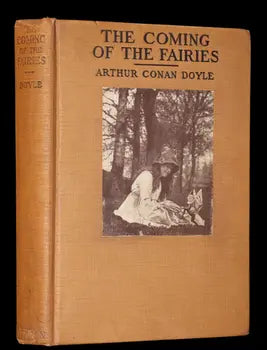
Arthur Conan Doyle: Delving into "The Coming of the Fairies"
Arthur Conan Doyle: Delving into "The Coming of the Fairies"

For many of us, the name Sir Arthur Conan Doyle immediately conjures up images of the iconic detective, Sherlock Holmes, and the fog-covered streets of Victorian London. Yet, Conan Doyle was not just a writer of detective stories. His oeuvre spanned across multiple genres including history, science fiction, and spiritualism. One of the lesser-known works, but a highly intriguing one, is “The Coming of the Fairies.”
The Background
Published in 1922, "The Coming of the Fairies" is a world away from the logical deductions of Holmes. This book details Conan Doyle's belief in the existence of fairies, using the famous Cottingley Fairies photographs as primary evidence. For those uninitiated, these photographs depicted two young girls from Cottingley, England, playing with what seemed to be real fairies.
The Cottingley Fairies
The Cottingley affair began in 1917 when two cousins, Elsie Wright and Frances Griffiths, claimed to have photographed themselves with fairies in their garden. These photographs stirred a sensation, dividing public opinion. Some believed they were undeniable proof of the supernatural, while skeptics dismissed them as elaborate hoaxes.
Conan Doyle, already invested in spiritual and supernatural studies, was introduced to the photographs in 1920. Enthralled, he believed they provided tangible evidence of psychic phenomena.
A Deep Dive into Belief and Skepticism
What makes "The Coming of the Fairies" particularly fascinating is not just Conan Doyle's firm belief in the veracity of the photographs but his arguments against the skeptics of the time. He passionately defends the innocence of the girls and delves into detailed analyses of the photographs.
Conan Doyle's foray into this realm was met with astonishment, especially from those who revered him for creating the epitome of logic and reason in Sherlock Holmes. It showcased a stark contrast: the author who championed logic was also a steadfast believer in the mystical.
Conclusion and Legacy
In the end, the truth about the Cottingley Fairies did emerge. In the 1980s, long after Conan Doyle's passing, the now elderly Elsie and Frances confessed that the photographs were indeed faked. The fairies were cardboard cutouts, though Frances maintained that they really did see fairies in the garden.
"The Coming of the Fairies" remains a testament to the varied interests of Arthur Conan Doyle. For bibliophiles, it offers an insight into a side of Conan Doyle that is often overshadowed by his more famous works. Whether you pick it up as a believer in the supernatural, a fan of Conan Doyle, or simply out of sheer curiosity, it's a fascinating read that chronicles a unique chapter in literary history.
In the end, it's a reminder that even the most logical minds have a space for wonder, mystery, and a touch of magic.
Happy reading!
Your Friends at MFLIBRA Antique Books.
Search for "The Coming of the Fairies" copies on MFLIBRA